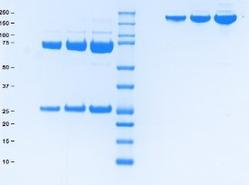
Immunoglobulin E, Lambda (IgE M Lambda)
Product Sizes
0.1 mg
16-16-090705-M-LAMBDA-0.1MG
1 mg
16-16-090705-M-LAMBDA-1MG
About this Product
- SKU:
- 16-16-090705-M-LAMBDA
- Additional Names:
- Allergy, Aptamer, Glycoproteomics, In Vitro Diagnostic, Inflammation, Biosensors, ELISA Standards, Parasitic Infections|IgE-L Myeloma
- Application:
- ELISA
- Buffer:
- Frozen in 15 mM potassium phosphate, pH 7.4, with 150 mM NaCl and 0.05% NaN3.
- CE/IVD:
- RUO
- Extra Details:
- Serum immunoglobulin E (IgE) is the least abundant antibody class in human plasma, circulating at concentrations below 0.6 ug/mL in healthy individuals. This monomeric glycoprotein features a unique Fc region with seven N-linked glycosylation sites, including a conserved oligomannose glycan at Asn394 critical for structural stability and binding to the high-affinity receptor FcE EpsilonRI. IgE mediates type I hypersensitivity reactions by binding FcE EpsilonRI on mast cells and basophils, triggering degranulation and release of histamine, leukotrienes, and cytokines upon allergen exposure. Beyond allergies, IgE plays a protective role against parasitic infections like helminths by activating eosinophils and basophils to release cytotoxic granules. Elevated serum IgE (>300 IU/mL) is a hallmark in allergic conditions such as asthma, atopic dermatitis, and allergic bronchopulmonary aspergillosis (ABPA). Hyperimmunoglobulinemia E syndromes (HIES), caused by STAT3 mutations, present with recurrent infections, eczema, and IgE levels exceeding 2,000 IU/mL. IgE multiple myeloma, a rare plasma cell malignancy, produces monoclonal IgE with normal structure but lambda light chain predominance, often complicating renal function. Parasitic infections and viral diseases like HIV also drive polyclonal IgE elevation. Clinically, total IgE quantification aids in diagnosing ABPA and monitoring omalizumab therapy, an anti-IgE monoclonal antibody that reduces free IgE levels by forming inert complexes. Despite its short serum half-life (2-3 days), cell-bound IgE persists for weeks on immune cells, necessitating combined plasma and cell-bound IgE measurements for accurate allergy diagnosis. Myeloma-derived IgE remains invaluable for structural studies due to its intact glycosylation and receptor-binding properties. Emerging therapies targeting IgE-FcE EpsilonRI interactions and glycosylation pathways aim to modulate allergic responses while preserving protective functions.
- Formulation:
- Frozen in 15 mM potassium phosphate, pH 7.4, with 150 mM NaCl and 0.05% NaN3.
- Molecular Weight:
- 190,000 Da
- Physical State:
- Frozen
- Purity:
- ≥95%
- Purification:
- Liquid Chromatography Methods
- Shipping Conditions:
- Dry Ice
- Source:
- Source human myelomaplasma non-reactive for HBsAG, anti-HCV, anti-HBc, and negative for anti-HIV 1 & 2 by FDA approved tests.
- Storage Conditions:
- Please refer to datasheet
- Supplier:
- Athens Research & Technology Inc.
- Type:
- Antibody: Isotype Controls


